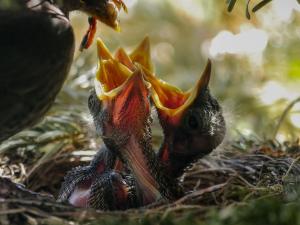Young bird

If you find a young bird,
inspect it to see whether it has feathers and if it is injured:
- The bird does not have feathers
It is a nestling. Look for the nest and observe whether the parents still come back to it.
Then put the nestling back in the nest!
The parents will take care of the nestling again. Pick up the nestling carefully, preferably with gloves on or with your hand in a wash cloth.
This is to protect the nestling's delicate skin, not to avoid a human scent (the parents are not 'bothered' by a human scent).
- The bird does have feathers
If the bird has feathers, it is a fledgling. Often young birds sit on the ground for a few days, sometimes they are still fed there by their parents. If there is no danger, for example a cat, the fledgling can be left where it is.
If there is any danger, move the bird to a safer place, such as under a hedge, in a hanging basket or in a gutter.
If this is not possible, you can take the bird to the sanctuary. Put the animal in a box with a cloth over it, this calms the bird, and take it to the sanctuary.
- The bird is injured
If the bird is injured, for example because it has been caught by a cat or hit by a car, pick it up with gloves or a towel.
Put the animal in a box with a cloth over it, this calms the bird, and take it to a sanctuary that offers the appropriate care.
- Beware: a young bird is afraid of people!
A young bird is a 'wild' animal that is afraid of people!
So a bird that sits in your hand with its eyes closed while being caressed is not enjoying the experience; it is in shock!
A young bird may die from the effects of that shock: so leave it alone and don't touch it unnecessarily.
We recommend only bringing young birds to the sanctuary if you are sure the parent bird is dead or the young bird is injured.
You can also always call us for advice: +31 (0)223 - 62 05 86 or +31 (0)657072575 (after closing time)
More information about young birds
Never try to raise the young bird yourself!
The chances of failure are high and most birds are protected by the Dutch Flora and Fauna Act. So having wild birds in your possession is a criminal act!
Young birds will ‘imprint’ on humans and identify them as their species. As a result, they will never be able to survive in the wild again because they have not learned to socialise with other members of their species. So despite all your good intentions, raising a bird in a human environment is very harmful for the bird!
Will the parents come back, if I have already touched the bird?
People often believed that the parents do not return to their young after being touched by humans. This is absolutely not true!!! Birds have a poor sense of smell (except vultures) so they won't notice if you touch their young, however, they do get agitated when you get too close to their young.
Young fledglings
In spring, you often see a young bird with hardly developed feathers sitting on the ground under a tree and you automatically assume that it has fallen out of the nest and needs help. At this stage of the bird's development, we call these youngsters 'fledglings'. It is normal for fledglings to jump or fall out of the nest. The young birds have now reached the stage where they are learning to fly. The parents carry on feeding the young bird on the ground until it is able to fly (this usually takes a few days). Unless the bird is injured, you should leave these young birds alone. Try to keep children, dogs and cats away from them so the parents can carry on raising their young.
What if dogs or cats threaten the bird?
If you see a young bird being threatened by a dog or cat, don't bring the bird directly to the sanctuary. Instead, try to keep the pet out of the way while the bird is down on the ground. However, if the bird has already been attacked or grabbed and is injured, you need to get it to the sanctuary as soon as possible.
Remember.....
A young bird has the best chance of survival when it is raised by its own parents. Always try to put a nestling back first. Only take a young bird to the sanctuary if you have done everything possible to reunite it with its parents but were unsuccessful in your efforts.
Bird sanctuary address
Vogelasiel De Paddestoel
Jan Verfailleweg 620A
1783 BW Den Helder
Telephone: +31 (0)223 - 62 05 86 or +31 (0)657072575 (after closing time)




